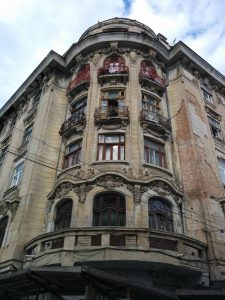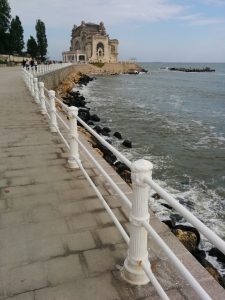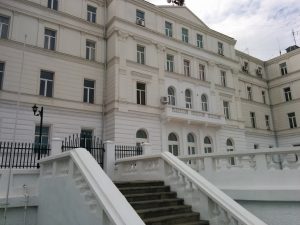One of the unexpected discoveries in Europe is to be found at its eastern borders, on the edge of the Black Sea: Constanta – the largest harbour on the Western shores of Black Sea. Practically the oldest continuously inhabited town on the present territory of Romania, Constanta’s history spans from the Helenistic era over the Roman times, the Byzantine rule, the Bulgarian kingdom, the Genoese, the Ottoman empire, the Romanian kingdom, the communist exercise, the transition period and lately the European Union funded reconstruction.
Inspite the fact that cruising ships are more frequent these days due to the political turbulences in Ukraine’s romantic sea city of Odessa, the city of Constanta is still not ready to join the long list of sanitized European cities. It’s still dusty and rand down but its glorious history transpires at every corner. If you are convinced that beauty lies in imperfection, than this is your city.
First Flavours
There is a beauty and flavour attached to it that is very similar to Havana. Both are embellished by decadent but elegant turn of the century palaces, have a long seaside promenade and their impoverished population, skinny cats and vagabond dogs give a nonchalance taste to your stroll.
The Greek Origins
The historic center is places on the hill surrounded by the Greek town’s walls with the sea front on the Eastern side. You can start your visit at the city’s History Museum where the highlights are the Greek period statues – Glykon the Snake, Fortuna and Ponthos – protectors of the family, the harbour and the city.
Around the year 600 BC, the Greeks started to explore new shores of the Mediterranean and Black seas, looking to establish new Greek cities. They called this town Tomis. Not far from here there is an island where the Greek mythology places the tomb of Ulysses.
The Sad Poet
The Romans are taking over the town in the year 29 BC. To get a feel of the new patrons’ interiors, next to the museum there is a structure covering a gigantic Roman mosaic.
But probably the most important Roman figure linked with the town of Tomis is the poet Ovid (Ovidiu) (43 BC – 17 AC) who was exiled here by the Roman Emperor Augustus. The poet doesn’t talk too much about the cause of his exile. He mentions just “a poem and a mistake”. Bad mouths say it was for adultery with the emperor’s daughter, Julia. He is sent on the most remote margins of the empire “in a war-stricken cultural wasteland”. Ovid was burned inside by the longing feelings to his beloved Rome. His longing and sadness was captured in his poems “Tristia” (“Sorrows”) and “Epistulae ex Ponto” (“Letters from the Black Sea”). The first one includes his own epitaph that can be read at the feet of his statue in Constanta:
- fell victim to my own sharp wit.
- the traditional prayer: ‘May Ovid’s bones lie soft’
The statue was done in 1887 by the Italian sculptor Ettore Ferrari and is located in the main square of the city.
Flavour from the Middle East
If you close your eyes and open your senses you may hear the call of the muezzin for the Muslim pray. You can’t miss the visit to Constanta’s Grand Mosque (also known as ‘Carol I Mosque’) built by the Romanian king Carol I in 1910-1913 to mark the inclusion of the province of Dobrogea to the Kingdom of Romania. Its inspiration was Konya Mosque in Anatolia.
The interior decorations are minimal, but the piece de la resistance lays in the experience you will get by climbing the 47 meter heigh minaret where the panorama of the town unfolds on the blue background of the sea.
Ottoman Diversity with French Perfume
The Ottomans took over the region in 1419 and created many settlements with Turkish names (Babadag, Medgidia, Techirghiol, Cogealac etc).
During the Ottoman rule many other faiths and ethnic groups found welcoming grounds to live, work and practice their religion. The Jews (see the tall sun washed synagogue), the Genoese (their lighthouse pins so elegantly the seaside promenade), the Armenians, Greeks with their rich trade-men’s palaces. All this human multicultural ingredients contributed to the town’s bubbling life that started to ferment at the end of 1800s. It is the period when the historic province of Dobrogea became part of the Romanian Kingdom that absorbs every single drop of life and inspiration from the French society and culture at the turn-of-the-century. The most impressive building of the town is the white washed Casino built by the French architect Daniel Renard in 1910. Unfortunately today it is a crying building that does not get any love, attention and care obviously for local political interests.
Benefiting of a great geo-position, the harbour of Constanta started to develop at a large scale into one of the largest in the Black Sea. The English became interested. The ‘Danube and Black Sea Railway’ company builds a hotel in 1881 that later becomes the home of admiralty. It looks cropped and pasted directly from Edwardian London or Dublin.
Palaces, Churches & Art Deco Villas
Harbour towns are fascinating places. With the in and out of ships, sailors, merchandise and people, ideas are exchanges. Progress and vice come hand in hand. And the historic center of Constanta embraces them all: Catholic or Orthodox churches, mosques, synagogue, banks, lavish villas, schools, caffes, the brothel. The 20s and the 30s fuel the Romanian economy with loads of foreign capital for its top commodities like cereals and petrol. Beautiful Art Deco & Bauhaus villas popped up across the center featuring the predilection of Romanian architects for navy inspired decorations (hublot style windows, most shaped antenna, vertical shaped illuminators for the staircases). From the same period are coming the strong, muscular statues of Ion Jalea, whose museum can be found by the Greek walls facing the sea.
“Havana of the East” is changing everyday. Pavement and infrastructure is slowly changed, the poverty mopped and hidden to newly built properties in the outskirts of the city and the straight animals picked up. The process is slow, so no need to hurry. But surely with every window frame changed, something from the charming past is getting lost.
Before you grab your rucksack to take the first boat to Istanbul (353 km), the first train to Bucharest (222 km) or the local bus to the nearby sea resorts don’t miss the restaurant and bar called “Crazy”. Packed with Swedish style design and good taste it appears like a flashback from the future. Located conveniently by the Olympic Hall and its leafy park, the terrace offers an amazing food experience.
Useful Link
The stop by stop walking tour described in this page could be found on this map:

















